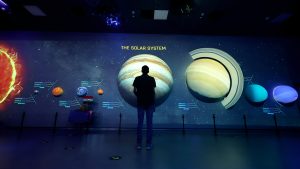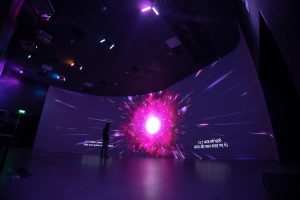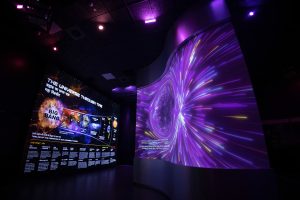BUDGET: 11 crore INR and above (USD1.48 million and above)



PROJECT OVERVIEW
The Jhansi Space Museum project, initiated by Avanish Rai, IAS, aimed to create a world-class facility in Jhansi that matches global space museum standards. Pan Intellecom, known for immersive experiences, embraced the challenge of delivering a cutting-edge experience using advanced technology. Designer Avijit Samajdar and Pan Intellecom’s team developed engaging and accessible content for young visitors, with insights from experts.
The museum showcases advanced technologies like kinetic models, projection mapping, holograms, immersive games, and more, offering a comprehensive visitor experience. Key developments included redesigning the reception, adding a Chandrayaan 3 model after India’s moon landing, and enhancing interactivity with independent holographic projections. Meticulous planning ensured the building’s structure aligned with technological needs, addressing logistical and installation challenges.
Informed by extensive research and visits to international science centres, the museum highlights historical and modern astronomical achievements, providing an enlightening experience.
WHAT DID THE CLIENT WANT TO ACHIEVE?
The client, Jhansi Smart City Ltd., aimed to establish a world-class space museum in Jhansi. The primary goal was to create a facility that would be on par with the best in the world, offering an immersive and educational experience for young visitors. The museum was envisioned to ignite curiosity and foster a deep understanding of the Universe, using the latest technology and engaging content.
The client wanted the museum to highlight both historical and contemporary contributions to astronomy, including the achievements of ancient Indian astronomers like Aryabhatta. The intent was to blend educational content with cutting-edge technological displays, making complex astronomical concepts accessible and engaging.
By incorporating kinetic models, blended projections, holograms, interactive screens, and immersive experiences, the museum sought to create an enriching environment that would captivate and educate visitors of all ages. The ultimate aim was to inspire the younger generation, encouraging them to explore and appreciate the wonders of space and science while also honouring India’s rich astronomical heritage.
SCOPE OF WORK YOUR COMPANY WAS INVOLVED IN
PAN Intellecom played a crucial role in the development of the Jhansi Space Museum, designing and executing various technological and immersive elements within the museum and its building. Working closely with subject matter experts and concept creators, the team ensured the project met international standards.
Led by an internationally acclaimed designer, they implemented technologies such as:
Kinetic Models: Showcased human exploration and Chandrayaan 3.
Blended Projections: Illustrated the origin and expansion of the universe.
Projection-Mapping: Depicted the dynamic solar system and historical Indian astronomical discoveries.
Holograms: Demonstrated the birth, life, and death of stars.
Multi-surface Immersive Experiences: Focused on Earth and its relationship with humanity.
Full Dome Projection: Provided a journey to the edge of the known universe.
Immersive Games: Simulated space exploration.
PAN Intellecom meticulously planned the building’s structure to accommodate advanced technology, including high roofs, acoustic treatments, and installation logistics. Collaborations with experts like Dr. Debiprosad Duari ensured scientific accuracy and educational value. Overall, PAN Intellecom’s efforts resulted in a state-of-the-art museum that inspires and engages visitors.
WHAT KEY CHALLENGES WERE FACED?
The development of the Jhansi Space Museum posed several key challenges:
Synchronization with Physical Structure: One significant challenge was integrating the technological modules with the building’s physical structure. The design incorporated high-tech installations like tall ceilings for kinetic humanoids and the Chandrayaan 3 model. The dome received acoustic treatment for Surround Sound, and walls supported large signages and backlights while maintaining acoustic integrity.
Installation Logistics: Another challenge was managing the logistics of installing sophisticated equipment on-site. This involved handling delicate and complex systems, intricate cable and conduit installations, and ensuring that all components were correctly installed.
Incorporating Feedback and Adjustments: Feedback from Jhansi Smart City authorities drove multiple adjustments, such as redesigning the reception area and adding a Chandrayaan 3 model post-India’s 2023 moon landing. Balancing these posed significant challenges.
Budget and Time Constraints: The team remained committed to delivering a world-class product despite time and budget constraints. This required prioritizing essential features, streamlining processes, and optimizing resources to ensure high-quality outcomes.
HOW WERE THOSE CHALLENGES RESOLVED?
Jhansi Space Museum posed challenges resolved through meticulous planning, innovation, and collaboration:
Synchronization with Physical Structure: Integrating technological modules involved designing high roofs for kinetic humanoids and the Chandrayaan 3 model in the reception area. The dome was acoustically treated for Surround Sound.
Installation Logistics: Installing sophisticated equipment necessitated meticulous planning and coordination. Delicate systems were carefully handled to ensure accurate installation, with detailed planning for cables and conduits to streamline operations.
Incorporating Feedback and Adjustments: Flexibility to adapt to feedback led to a complete redesign of the reception area and the inclusion of a Chandrayaan 3 model post-India’s moon landing. Holographic projections enhanced interactivity and were seamlessly integrated while maintaining project integrity.
Budget and Time Management: Despite constraints, prioritization of essential features and streamlined processes optimized resources, ensuring timely delivery of a high-quality museum.
Collaboration and Support: Support from Jhansi Smart City authorities and stakeholder feedback played pivotal roles in overcoming challenges, ensuring a state-of-the-art museum offering an enriching experience.
HOW HAS YOUR WORK HELPED THE CLIENT?
The Jhansi Space Museum has profoundly benefited Jhansi Smart City Ltd. in several significant ways:
Firstly, it has positioned Jhansi as a location boasting a world-class facility, aligning with the client’s ambition to rival international standards and elevate the city’s profile.
Secondly, the museum offers an unparalleled educational experience, simplifying complex astronomical concepts through interactive technologies like kinetic models, holograms, and interactive screens. This initiative aims to inspire young minds while highlighting historical and contemporary contributions to astronomy.
Additionally, the museum effectively showcases India’s rich astronomical heritage, using projection mapping and immersive experiences to narrate the achievements of ancient astronomers like Aryabhatta and modern scientific breakthroughs.
Moreover, the museum’s interactive features, including games and quizzes, ensure high visitor engagement, making it a popular destination for families and educational trips.
Lastly, the project’s successful execution amid challenges underscores the client’s commitment to quality and innovation, receiving positive feedback and solidifying Jhansi Smart City Ltd.’s reputation for pioneering world-class projects in smaller cities.
WHAT ARE YOU MOST PROUD OF ABOUT THE PROJECT?
The Jhansi Space Museum project stands as a testament to PAN Intellecom’s dedication to innovation, quality, and educational enrichment. We take pride in seamlessly integrating cutting-edge technology with compelling content to create an immersive educational experience for visitors of all ages.
Our meticulous planning ensured the synchronised integration of advanced technological installations with the museum’s physical structure. Dynamic features such as kinetic models, holograms, and projection mapping showcase our ability to blend creativity with technical expertise. The reception area, featuring a mural of Aryabhatta animated through projection mapping alongside kinetic humanoids, celebrates India’s scientific legacy and our innovative approach.
The overwhelmingly positive public response and the educational impact on young visitors underscore the success of our efforts. Witnessing visitors inspired and engaged by the museum’s exhibits validates our commitment to delivering a project that enhances Jhansi’s cultural standing while fostering curiosity and learning about the universe.
VIDEO:











